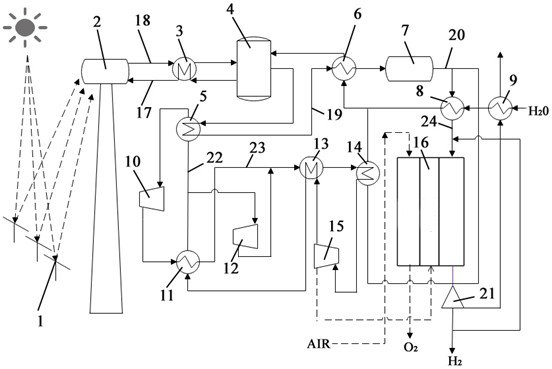Solar high-temperature electrolyzed water coupling hydrogen production system and process based on amino thermal chemical energy storage
A high-temperature electrolysis and thermochemical technology, used in the chemical industry, electrolysis components, electrolysis process, etc., can solve the problems of incomplete conversion, harsh reaction conditions, and high operating costs of energy storage systems, and achieve strong fluidity and low compressibility. , The effect of high heat transfer efficiency
- Summary
- Abstract
- Description
- Claims
- Application Information
AI Technical Summary
Problems solved by technology
Method used
Image
Examples
Embodiment 1
[0026] The direct solar radiation intensity is taken as 1kW / m 2 , the concentration ratio is 200, aiming to test the feasibility of the system under ordinary illumination and concentration conditions; provide the required heat for the ammonia decomposition reaction in the endothermic reactor 2 and maintain the reaction temperature through the solar heat collection device To ensure the progress of the reaction, the endothermic reactor 2 has a length of 355mm and a diameter of 30mm; liquid ammonia is exchanged from the normal temperature pressure storage tank 4 to the first heat exchanger 3, and the temperature rises from normal temperature to about 400°C and enters the endothermic Reactor 2, ammonia decomposition reaction occurs in endothermic reactor 2 to make the product N 2 、H 2 The temperature rises to about 700°C, then enters the first heat exchanger 3 for heat exchange, and is finally stored in the normal temperature and pressure storage tank 4; the N stored in the norma...
Embodiment 2
[0028] Liquid ammonia is exchanged from the normal temperature pressure storage tank 4 to the first heat exchanger 3, and the temperature rises from normal temperature to about 400°C and then enters the endothermic reactor 2, where the ammonia decomposition reaction occurs to make the product N 2 、H 2 The temperature rises to about 700°C and enters the first heat exchanger 3 for heat exchange, and is finally stored in the normal temperature and pressure storage tank 4; the N stored in the normal temperature and pressure storage tank 4 2 、H 2 First enter the fifth heat exchanger 5 for heat exchange to raise the temperature from normal temperature to about 250°C, the total flow rate of the reaction gas is 4.25g / s, then enter the second heat exchanger 6 for heat exchange to raise the temperature from 250°C to 630°C , and finally enters the adiabatic reactor 7 for the synthesis of ammonia. The length of the adiabatic reactor is 115cm, and the length of the adiabatic reactor is 18...
Embodiment 3
[0030] Liquid ammonia is exchanged from the normal temperature pressure storage tank 4 to the first heat exchanger 3, and the temperature rises from normal temperature to about 400°C and then enters the endothermic reactor 2, where the ammonia decomposition reaction occurs to make the product N 2 、H 2 The temperature rises to about 700°C and enters the first heat exchanger 3 for heat exchange, and is finally stored in the normal temperature and pressure storage tank 4; the N stored in the normal temperature and pressure storage tank 4 2 、H 2 First enter the fifth heat exchanger 5 for heat exchange to raise the temperature from normal temperature to about 250°C, the total flow rate of the reaction gas is 4.36g / s, then enter the second heat exchanger 6 for heat exchange to raise the temperature from 200°C to 620°C , and finally enters the adiabatic reactor 7 to generate ammonia. The length of the adiabatic reactor is 120cm, and the length of the adiabatic reactor is 20mm. The ...
PUM
| Property | Measurement | Unit |
|---|---|---|
| diameter | aaaaa | aaaaa |
Abstract
Description
Claims
Application Information
 Login to View More
Login to View More - R&D
- Intellectual Property
- Life Sciences
- Materials
- Tech Scout
- Unparalleled Data Quality
- Higher Quality Content
- 60% Fewer Hallucinations
Browse by: Latest US Patents, China's latest patents, Technical Efficacy Thesaurus, Application Domain, Technology Topic, Popular Technical Reports.
© 2025 PatSnap. All rights reserved.Legal|Privacy policy|Modern Slavery Act Transparency Statement|Sitemap|About US| Contact US: help@patsnap.com

